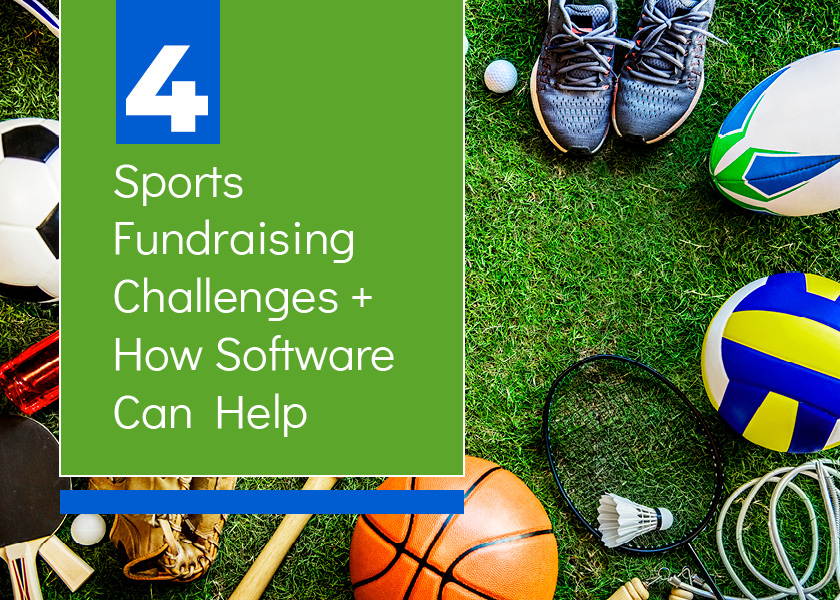4 Sports Fundraising Challenges + How Software Can Help

As the spring months begin to come to a close, so does the school year. But for your football team, you’re just getting started preparing for the next season. As a coach, you’ve been busy recruiting new players and holding routine practices. However, you quickly realize that your team is in trouble: you need new equipment for training, but the team doesn’t have the funds.
With such a short timeline before classes end, how will you reach enough supporters to fund your summer training sessions? How can you organize an entire campaign and communicate these efforts with players and supporters in a few short weeks?
Rest assured that these challenges are common for sports teams, clubs, and schools. Luckily, there are simple (and affordable) solutions available. For example, choosing a platform that supports your online-based fundraising ideas will help you overcome any setbacks so you can quickly set up a fundraiser.
In this guide, we’ll address four common fundraising problems that sports teams face and how to fix them. Let’s get started!
1. Limited reach and resources.
Your local community can offer loyal, powerful support to your team. While you should never discount the impact of local support, being limited to only this donor pool can lead to fundraising troubles. Your community has a finite number of willing supporters, and you’ll be competing with other schools, teams, and organizations for their fundraising dollars. Over time, these supporters could become fatigued and even withdraw their support.
To avoid these risks, it’s paramount that your team reaches beyond town borders for support. Without the right fundraising resources, however, it might feel intimidating to try to reach supporters outside of your familiar community.
Here are a few easy ways to reach more donors and increase the number of resources at your disposal:
- Fundraise online. Launching your fundraiser online (and accepting online donations) allows your team to reach people across the country. Taking campaigns online quickly increases your potential donor pool from the thousands of people in your town to the millions of users on the internet. Plus, spreading awareness online is free.
- Use a fundraising platform. Fundraising software gives you the tools you need to manage the small (yet important) details of your fundraiser. 99Pledges’ baseball fundraising guide explains that a fundraising platform “can help you more easily sign up participants and collect donations to keep your fundraiser organized and efficient.”
- Leverage digital marketing. Marketing your fundraiser online will help you increase reach by strategically promoting your fundraising campaign to your target audience. Go beyond just making one or two posts on your team’s Facebook page. Share compelling calls-to-action across a variety of platforms, making sure to include helpful links and details so supporters can quickly take action.
Making supporters aware of your fundraiser is the first, most crucial step toward fundraising success. Once you’ve captured their eyes, take advantage of your share of their attention by clearly explaining the purpose and goals of your campaign to compel readers to learn more about how to get involved.
2. Short fundraising timelines.
Because sports seasons (combined with academics) can be so busy, there isn’t always a lot of time left for planning fundraisers. Additionally, unforeseen expenses can always pop up. For example, what if a school bus breaks down and your soccer team quickly needs to raise enough to pay for transportation to its next championship game?
When you’re short on time, make sure to partner with a fundraising platform that can help you get started as soon as possible so you have at least two to three weeks to promote the campaign and collect donations from supporters.
Additionally, having a strong digital presence can help you maximize revenue, even if you have less than a month to meet your goal. To prepare for these unexpected situations and build an audience of online supporters, use these tips:
- Maintain consistent branding across all platforms.
- Use a variety of digital communication channels (e.g., popular social media platforms, email, websites) so supporters can engage through their preferred channels.
- Make regular posts about a variety of topics like try-out reminders, practice schedules, event announcements, and fundraising-related content.
- Cross-promote your social media accounts and other ways to sign up for the fundraiser or donate.
While you’ll see the best results from fundraisers that are planned well in advance, these long timelines won’t always be the reality for your team. To prepare for any unforeseen fundraising needs, prioritize building a loyal community of online supporters and selecting software with a quick turnaround.
3. A lack of data.
Have you ever organized, launched, and promoted a fundraiser, only to end it without a clear idea of the campaign’s performance?
Say a basketball team hosts an annual walk-a-thon fundraiser in which they collect pledge donations for each mile their participants walk. In the past, participants would gather pledges using paper forms. Then, the team would hold the walk-a-thon and add up the funds after the event. In these cases, the team had no way to know how close it was to the fundraising finish line until after the event.
So, how did this team turn things around? They partnered with a fundraising platform that creates individual, online donation pages for each participant. The software aggregated this data to show coaches the team’s overall fundraising progress, helping them make big pushes to reach the goal in time—without any of the guesswork.
In addition to using a platform that shows your team, club, or organization real-time progress, keeping data clean and organized is essential. NPOInfo’s data management guide recommends keeping all of your data in one place, reviewing it regularly, and developing guidelines for how to enter and analyze data. Over time, you can use information gathered through donation forms to predict donors’ behaviors and tailor marketing campaigns to their preferences.
4. Disorganized campaigns and communication.
When you’re working with a limited time frame or don’t have all of the fundraising resources you need, campaigns can quickly become messy. To get organized, communication is key.
Quality communication, whether that includes sending fundraising reminders to parents and participants or promotional email blasts to past supporters, is what will make or break your fundraiser. You’ll need to communicate effectively with your team of fellow fundraisers, explain your “why” to parents and supporters, tell athletes how to fundraise, and promote your campaign.
A fundraising platform is great for organizing the actual fundraising process, giving you more time to manage both internal and external communication. It simplifies donation collection after the fundraiser concludes, funneling all pledge donations directly to your team’s account so you don’t have to chase down cash or checks. Plus, after the fundraiser winds down, you can reference the contact information donors enter into your donation form to send them thank-you letters.
Fundraising challenges shouldn’t hold you back from the benefits of raising more to support your team. Instead, embrace the challenges and look for ways to make your team’s approach to fundraising more effective—starting with choosing a comprehensive fundraising platform designed to help teams like yours raise money.


